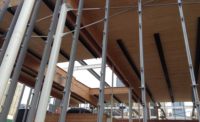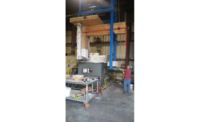The tally of how many defective cross-laminated timber panels need replacement on a $79-million college of forestry building under construction at Oregon State University is almost complete, nearly six months after two layers of a seven-layer CLT floor panel, 30 ft x 4 ft, came unglued and crashed 14 ft from the third to the second floor of the three-story building.
On March 14, after the failure, general contractor Andersen Construction Co., Portland, Ore., shut down construction. Work resumed on July 21 at the site of the George W. Peavy Forest Science Center at OSU's Corvallis campus. But the mishap caused a four-month delay and the opening of the approximately 80,000-sq-ft building, already delayed from this fall due to a switch in general contractors, is now anticipated in January 2020.
The March 14 failure, which caused no injuries and no structural damage, threw a big wrench in the works, triggering several investigations.
"Despite the setback related to the single CLT panel delamination earlier in the year, the Peavy Hall project is progressing in full swing," says Travis Baker, an Andersen regional vice president. "All parties involved continue to work together to ensure the completed building is 100% safe."
The March 14 failure, which caused no injuries and no structural damage, threw a big wrench in the works, triggering several investigations. And the project, intended as a showcase for mass timber products in Oregon and the U.S. Pacific Northwest, has turned into a complicated cautionary tale.
"This is clearly a very unfortunate situation that everyone takes seriously," says Michael Green, president and CEO of the project's architect, wood-building specialist Michael Green Architecture. MGA, headquartered in Vancouver, British Columbia, Canada, also has an office in Portland, Ore.
"The situation runs the risk of impacting how people feel about CLT," says Green, who informed all of his clients about the Peavy Hall problem. The situation is not having any impact on the "large number of MGA clients interested in CLT," he says. Green says MGA currently has 14 active wood projects around the globe.
OSU, the state's research land grant university, has been promoting CLT for more than three years, to revitalize the economy for timber farming and forest products in Oregon and the U.S. Pacific Northwest. "We remain confident in CLT and are working through the issues," says Steve Clark, OSU's vice president of university relations.
Engineered Wood
CLT is a prefabricated, engineered wood product made of at least three orthogonal layers of graded sawn lumber or structural composite lumber that are laminated by gluing with structural adhesives. The product has been in use in Europe for about 25 years. CLT has been used in the U.S. for about eight years.
Peavy Hall will contain 641 CLT panels, made from local Douglas Fir 2x6 boards. Of the 641 panels, 544 are floor panels and 97 are wall panels. Panels are supplied by D.R. Johnson Wood Innovations, Riddle, Ore.
A typical floor panel weighs 1.75 tons. The layers that fell weighed about a half ton, says Clark.
For construction, the L-in-plan building was divided into three, three-story zones--the legs of the L and the area where the legs join each other.
OSU estimates 500 panels had been installed as of March 14. The installation of 307 floor panels and 34 wall panels in zone one was complete. The installation of 188 floor panels and 41 wall panels in zone two, where the failure occurred, was under way. There were no panels installed in zone three, which will contain 71 panels.
The inspection and evaluation phase is not yet complete.
The inspection and evaluation phase is not yet complete. However, to date, 45 fabricated panels not yet erected in zone three need replacement because they do not meet manufacturing specifications. Sources close to the project, who decline to be identified, say the total number of problem panels or panels that failed inspection is about 100.
The entities investigating the delamination generally concur on the cause: a process change at the D.R. Johnson mill created poor bonding between the adhesive and the layers, in some panels. In a period of cold weather, in a mill that was not environmentally controlled, D.R. Johnson preheated the wood materials and applied structural adhesive between layers, which were then pressed into CLT billets and fabricated into panels.
Premature Curing
"Preheating the wood caused premature curing of the adhesive and resulted in poor bonding of the layers of 2 x 6s. That in turn caused the delamination and failure," says Clark. As a consequence of the delamination, D.R. Johnson stopped the practice of preheating wood materials and adopted new quality control measures, including product sampling, along with a number of process modifications, adds Clark.
One investigator, APA--The Engineered Wood Association, which certifies CLT fabricators based on its American National Standard PRG 320: the Standard For Performance-Rated Cross-Laminated Timber, concurs. “Early investigations indicate that a process change in the manufacturing introduced temperature variations in the laminations that inadvertently caused premature curing of the adhesive, resulting in dry glue lines and poor bonding,” according to a statement by APA, which first published the ANSI-APA standard in 2011.
APA certified D.R. Johnson's CLT in August 2015. The fabricator was the first U.S. supplier to receive PRG 320 certification. There are now three other certified U.S. suppliers and three in Canada, according to APA.
D.R. Johnson “has addressed this manufacturing anomaly and implemented additional manufacturing and quality control measures," says APA, which is auditing the process changes for effectiveness and to ensure continual compliance with the PRG 320 standard.
"In essence, there was more heat trapped in the panel than predicted, which caused the adhesive to cure prematurely and the adhesive did not bond properly one layer to another in some places," says Eric Karsh, a principal of project structural engineer, Equilibrium Consulting Inc., Vancouver, B.C., and a veteran of mass timber structural design. "Some panels were preheated but not in a way that would harm them," he adds.
Remaining Issues
Valerie Johnson, president of D.R. Johnson and one of 18 industry members on the College of Forestry's advisory "board of visitors," declined to be interviewed but provided the following, in a statement: “We are working closely with all of our Peavy Hall partners to address the remaining issues and are confident they will be resolved to the satisfaction of all parties involved."
Clark says OSU does not anticipate paying additional costs related to the CLT mishap and the delay.
According to Clark, Andersen authorized D.R. Johnson to resume manufacturing CLT products for Peavy Hall based upon the new manufacturing and quality control processes and the acceptance of these new processes by the APA and KPFF, the structural engineer OSU hired to investigate the situation. D.R. Johnson is now manufacturing all CLT materials in an environmentally controlled facility. Tests are done daily at D.R. Johnson by taking sample cores from every CLT billet manufactured.
BJ Yeh, director of APA's technical services division, says PRG 320 does not address preheating the wood. Performance standards, which consider the end result, "do not get into that kind of detail," he says. He adds that engineered products are not suitable for a prescriptive standard because each mill has its own slightly different production methods.
Karsh, Yeh and Green say they know of no other CLT delamination problem, in North America, Europe, Australia or New Zealand. "I never heard of this delamination problem before," says Green, who began designing using CLT more than a dozen years ago. Peavy Hall is MGA's first project with CLT supplied by D.R. Johnson.
Typically, APA inspects a mill 12 times each year. APA audits for D.R. Johnson, which remains certified, have increased, since the panel failure, says Yeh.
The Peavy Hall Structure
Peavy Hall's structure consists of glulaminated posts and beams with CLT panels for floors and walls. Roof panels consist of laminated veneer lumber rather than CLT, which is made from planks. CLT floor panels will be covered by a concrete overlay. Below the CLT floor, there will be a hung ceiling made from a decorative wood material.
Lateral resistance is provided by vertically post-tensioned CLT panels in shear walls scattered throughout the building. The PT allows the panels to go back to their original position after a major seismic or wind event. "This is an immediate re-occupancy design," says Karsh. The project represents the first vertically post-tensioned CLT shear wall in North America, he adds.
Following the failure, Andersen shut down work and placed shoring beneath the CLT flooring. Investigations, which included taking core samples, sent to an independent testing laboratory, were done by APA, Andersen, KPFF and D.R. Johnson.
Reasons for Replacing Panels
Green explains that some panels will be replaced because "there is a clear problem." Others will be replaced because, after all the panels were inspected in the field, some did not pass muster and therefore are not certified to PRG 320 by APA. Not every panel got tested in the mill, says Green.
The complex also includes Advanced Wood Products Lab, a 15,000 sq-ft research facility for developing and testing new wood building products. The $79-million development cost has risen from an estimated $60 million. The complex is funded by $30 million in state bonding, $11 million in university funding and $38 million from donations.
Before the CLT panel failed, the project was already delayed, in large part due to a switch in general contractors, in part indirectly related to D.R. Johnson. The fabricator was part of the project with both Walsh and Andersen, because it is the only certified CLT fabricator in the 300-mile supply radius stipulated by OSU in the project specifications.
In September 2015, OSU signed a contract with Walsh Construction, Portland, Ore., that targeted a maximum price of $46 million for direct construction costs. According to its agreement with Walsh, the university had the right prior to signing a guaranteed-maximum-price (GMP) agreement to end the agreement without cause.
"The university made the decision to terminate the agreement after recognizing that Walsh Construction was not in alignment with OSU’s vision for this complex’s construction and the roles and responsibilities associated with its completion," says Clark.
Schedule and Cost Risks
Walsh wanted contract modifications that would shift schedule and cost risks, associated with the CLT, to the university, adds Clark. Walsh also requested an interest payment of 1% per month for all payments the firm paid its subcontractors that had not yet been reimbursed by OSU. The university's contract terms call for a 75-day repayment. Walsh sought the repayment as way of offsetting cash-flow impacts that the 75-day terms might have on its subcontractors, says Clark.
"We sought to modify the schedule/cost risk issue specifically related to the supply of the CLT material based upon the fact that a single-source supplier was specified [by OSU] and, if delivery and/or quality issues arose, no other approved manufacturer was available," says Bob Walsh, president of Walsh.
Andersen replaced Walsh as the general contractor in January 2017. The GMP is currently $62.9 million, based on the escalated cost of construction that had occurred over nearly 18 months throughout the Pacific Northwest, and due to the scope of the project increasing due to greater fund-raising success, says Clark.
"Had the university and Walsh remained under contract, the amount to be paid Walsh would likely have increased by the same amount estimated to be paid Andersen," he adds.
D.R. Johnson, a subcontractor to installer StructureCraft Builders Inc., Abbotsford, B.C., makes CLT in billets and cuts the billets into the various specified sizes of CLT panels. StructureCraft, which prepared a 3D model of the CLT components, installs steel and metal components on the CLT panels and erects them.
Though APA did not issue a formal notice to its members about the problems at Peavy Hall, "everyone is aware of the issue and has looked at their own manufacturing process to make sure they do not make the same mistake," says Yeh. "We are a small community."






Post a comment to this article
Report Abusive Comment